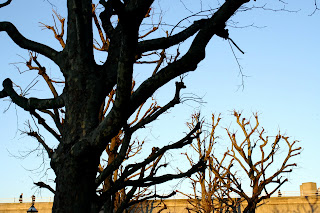In addition to the three concerts I described, and the effect of their space and audience on the performances, I will proceed to analyze two theater works I have seen in a similar manner. These two staged performances were of Andrew Lloyd Webber's By Jeeves and Richard Wagner's Parsifal. By Jeeves was a very low-budget performance, taking place on the first floor of a pub with only three rows of seating surrounding the stage. The small, dark space did not provide the actors much room to move, and so there was no defined boundary between the audience and the allocated performance space. As part of the show, for example, one actor handed out sandwiches to random audience members, making us feel and appear to be onlookers not only to the musical, but also to the character of Jeeves himself as if we were in the musical. Even though the car Jeeves drove was clearly a cardboard box, the low-budget production of the show did not detract from its believability since the audience felt like part of the show. On the other hand, seeing Wagner's five and a half hour performance of Parsifal at the English National Opera was a very different artistic experience. This time, I was one of hundreds of audience members, overlooking the elaborate staging from a balcony. Most of the audience looked much older and more well dressed than I was, creating a social gap and disconnecting me from the overall experience a bit. However, the man snoring behind me made me feel much more like a part of the experience than some. The costumes looked like they were elaborate, though I could hardly see from my seat, and seeing this work was much more introspective than any others I have gone to lately. Yet, it was during the two intermissions, one being forty-five minutes long, that the social interactions and connections mostly clearly took place. From this fact, and my observation that they did not seem to talk much about the performance during this time, I believe that being at the show, rather than the show itself, is more to some of the audience's interest. Whether seeing a couple kissing or an old man sleeping, I was led to feel a strengthened connection with the performance because of my actual interest in seeing and hearing it, which is further emphasized by the fact that I went to this five and a half hour event alone. This performance reminds me a bit of West End art galleries, filled with student tour groups, meandering tourists, and people who are looking just for the sake of it, rather than By Jeeves which is more like the smaller and more obscure galleries that are generally only found by those who are truly interested.
AZ


























